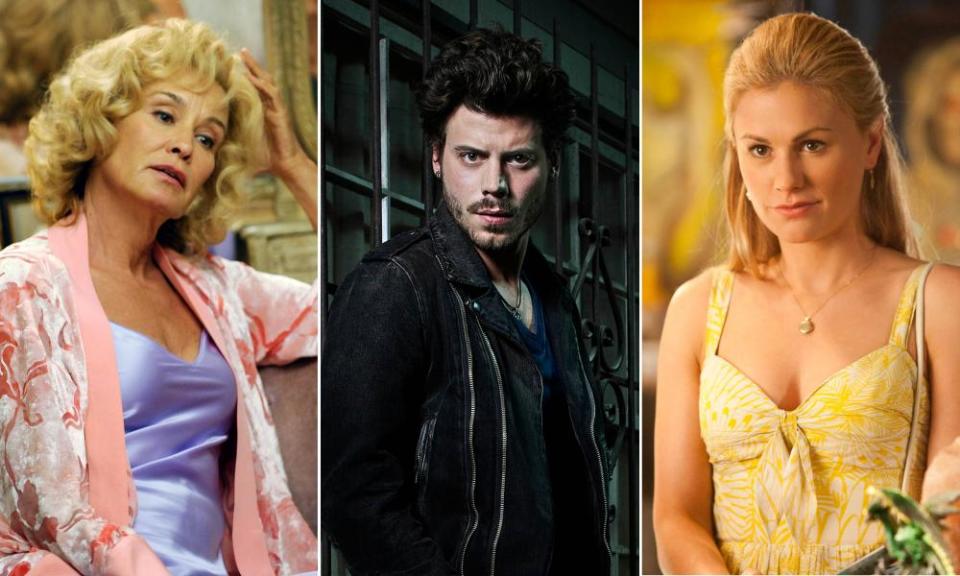How True Blood's supernatural hedonism changed genre television

Ryan Murphy. Shonda Rhimes. Noah Hawley. Equally deserving of a place alongside these architects of modern television is Charlaine Harris – perhaps an odd choice, considering the fact that the longtime novelist has never directly gotten her hands in the TV game. But as the writer behind the hot and heavy fantasy novels on which True Blood and the upcoming Midnight, Texas, are based, she’s done a lot to shape the current landscape of the supernatural on the small screen. For better – and, eventually, for worse – her approach to longform storytelling has colored much of what followed True Blood in its genre. And as the next major Harris adaptation touches down on the network airwaves, it can learn from the successes and shortcomings of its enchanted, perpetually horny forebears.
True Blood had the good fortune of arriving during a time when national interest in vampires and their lore had spiked at an all-time high, but the skill with which it sold itself set it apart from a large pack. The hothouse romance between Sookie Stackhouse and vampire hunk Bill Compton fused the supernatural amusements of Buffy the Vampire Slayer with a soap opera structure that favored season-long arcs over monster-of-the-week paranormal-procedural fare. But the real secret to the show’s success laid in creator Alan Ball’s undying quest to top the last provocation. He capitalized on the elasticity of “magic”, a concept that essentially eliminated all narrative restrictions on his over-the-top hedonistic style. The show began with the spotlight on vampires, but their weird universe rapidly grew in size, eventually incorporating werewolves, werepanthers, erotic fairies and parallel dimensions. Whenever things threatened to get stale, Ball could just throw a new occult variable into the equation for added freshness.
This worked like a charm, until it didn’t. The hazard of this anything-goes ethos of storytelling, which orients itself around the spectacle of novelty, is that it can only outdo itself so many times before spinning out of control. Unmoored from any laws governing its world, the show lost all sense of grounding and went haywire. Plot twists were freely doled out and undone when they became inconvenient, character traits were established then contradicted, and the supernatural elements eventually lost their luster as well. The show’s final years were sloppy and scattershot, a far cry from the inspired lunacy of its sophomore season (also known as “the orgy season”).
This method of constant reinvention to hold viewer interest motivated the recent anthology boom as well. American Horror Story, for one, followed True Blood’s same path, but with a series-long decline in quality condensed to each individual season. By beginning anew with a fresh premise and fresh cast every year, Ryan Murphy gave himself a reset button that could wipe away any and all writerly convolutions with a season finale. As such, every new batch of American Horror Story episodes begins bizarre and thrilling, only to eventually sputter into total incoherence about seven or eight hours in. The anthology structure freed Murphy up to cover more ground in the realm of the supernatural, but more than that, it gave him an escape route.
Other shows have devised ways to make the inevitable muddling of internal logic into a feature rather than a bug. After 12 seasons and 264 episodes, Supernatural is still going strong because it’s embraced its quirks of continuity to the point that the staggeringly complicated storyline has grown into a joke of its own. To make it work, the show’s been forced to retreat into its insular fanbase, but that same core viewership has been devoted and sizable enough to render the show viable seemingly indefinitely. If a show’s going to have to occupy a niche, it’s in that show’s best interest to fully ensnare its audience.
Midnight, Texas, is already at a disadvantage. NBC’s standards and practices department won’t let fly half of what True Blood got away with on HBO, meaning one of supernatural fiction’s most reliable generators of intrigue and titillation has been taken off the table. But they’ve still got plenty of lurid material to hold viewers’ interest, from psychics to witches to, yes, vampires. Now, the show lives or dies by the extent to which it can control itself while still maintaining that out-of-control feeling. Striking that elusive balance between the illusion of total narrative anarchy and an underlying sense of order requires delicacy and discipline. Historically, those have not been defining traits of Charlaine Harris’ bustling imagined world, a new series and new creative team means a new lease on serialization. Instead of hooking viewers by striving to do it all, perhaps this series can learn to keep them hooked by doing a few things expertly.
Midnight, Texas, starts on NBC on 24 July at 9pm and in the UK on Syfy on 27 July at 10pm

 Yahoo News
Yahoo News 